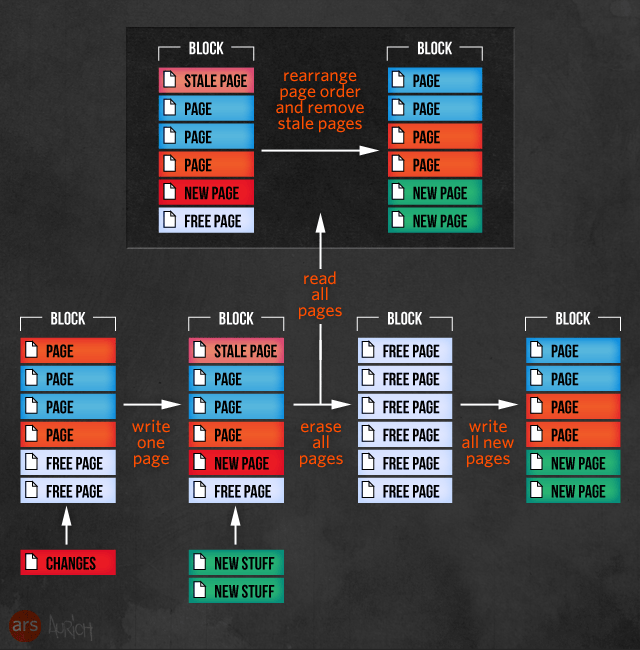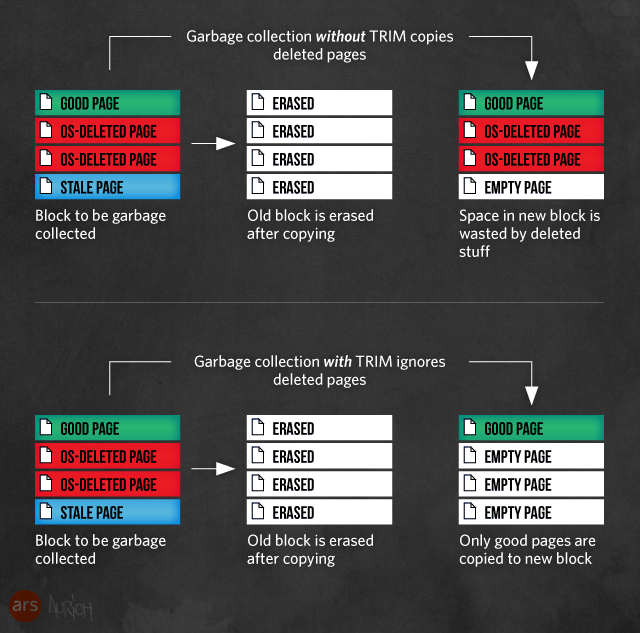Are All Modern Ssds Read Zero After Trim
Tech —
Enquire Ars: "My SSD does garbage drove, so I don't need TRIM… right?"
Mod SSD controllers are super-smart, but using TRIM is however a adept thought.

SSDs—how do they piece of work? Not with magnets.
Last week, we ran a syndicated piece from The Wirecutter on what the best consumer-course SSD is for nigh people to buy. In it, guest author Nathan Edwards issued this caveat about adding tertiary-party solid-state disks to Macs:
You should know that Apple doesn't back up TRIM (an operating-organisation-level garbage collection command) on 3rd-party SSDs. It was possible to work effectually this limitation in previous versions of Bone X, merely you lot can't practise it in Yosemite without opening up a security hole. If your SSD'southward controller has good onboard garbage collection algorithms, you should exist fine fifty-fifty without TRIM.
This sparked a pretty big discussion in the comments on the ATA TRIM control, SSD garbage collection, and whether TRIM is even needed if your SSD has garbage collection.
Here's the skinny: TRIM is never a requirement, merely it always helps, and you're always better off with information technology than without it. In this (relatively) brusk commodity, I'm going to explain why.
Now, this isn't going to exist an exhaustive look into how SSDs work. We have you lot covered if that'due south what you're looking for, though—but hit up this x,000 word monster I wrote a couple of years ago if you want every single particular of what goes on inside those magical little devices. Today nosotros're going to go through why you still become benefit from TRIM even on a modern SSD with super-efficient garbage collection. Information technology comes downwards to the fact that even though SSD controllers are brilliant and getting meliorate with every iteration, they still have no way of knowing what the operating organization is doing.
Blocks and files
Any modern storage device, be information technology an SSD or a hard disk drive or a wink-based USB stick, has 2 unlike "layers" of internal organization. The first is the hardware layer, or the "block" layer. Blocks are commonly defined during industry and are hard divisions—a hard disk drive's 512-byte or 4Kbyte sector size is a block-level construction, set past the factory and programmed into the bulldoze'southward controller. On an SSD, a block is a physical construct made up of some number of pages, which are in turn made up of some number of individual NAND cells. For SSDs, a page is usually 8KB and is the smallest construction an SSD can read and write.
Merely Windows, Os X, and Linux tin't come across into the physical structures of their disks—this has been true for decades, ever since logical block addressing became a matter. Abstracting abroad the physical characteristics of the disk lets the disk's controller use lots of tricks for more efficiently organizing data backside the scenes, and this is especially true of SSDs, which have a handbag of tricks that would brand Penn and Teller jealous.
Instead, operating systems have their own organizational schemes—file systems. Virtually reckoner-savvy people know at to the lowest degree a bit virtually the file system they're using—for modern Windows, it's NTFS; Bone X uses HFS+; and most Linux distros these days use ext4. Modernistic file systems impose their own sets of society on top of the disk's cake structures—each file organisation volition take its own cluster size and its own way of laying out files and storing its tables and journals.
There is a barrier between the earth of files and the world of blocks. The operating organization doesn't have whatsoever say in how an SSD's controller does its job or which blocks the SSD controller uses to write data—the OS knows all about its file arrangement, but nil about the blocks underneath. Similarly, the SSD's controller knows everything about what blocks are in apply and what blocks are gratis, but information technology has no mode of knowing which blocks correspond to which files.
And when the operating system deletes files, things get complicated.
Garbage collection—information technology might non mean what y'all think
SSDs tin can read and write at the page level—which is normally 8KB for modernistic drives—only they accept a peculiar failing in that they cannot erase at the folio level. SSDs can merely erase entire blocks, which are usually fabricated upwards of hundreds of pages. The reason for this (explained in much greater detail in our big SSD guide) is that erasing a page's contents requires zapping that page with a not-insignificant amount of voltage, and the NAND-style layout of all modern SSDs makes it prohibitively difficult to isolate that voltage to only the pages that need erasing.

SSDs can but be erased one whole block at a time.
This is 1 reason why earlier SSDs seemed to dull downward equally they aged. It'due south fast to write and fast to read, merely when the disk'south initial store of free pages ran out, the disk had to erase old blocks before writing new ones.
To forestall this undesirable situation from happening, mod SSDs run complex routines called garbage collection in order to always proceed equally large a reserve as possible of pristine empty blocks ready for writing. Garbage collection involves having the controller search through its inventory of written pages for pages that have been marked as "stale"—that is, they were written to and and so the data they contained needed to exist modified by the Os; considering changing the page'southward land is impossible without first erasing it, the changes are e'er written to new pages and the old pages marked dried. Garbage drove looks for blocks that contain a mix of good and stale pages and so duplicates all the good pages into new blocks and leaves behind only stale pages in the onetime block. Then it erases the old block and marks it ready for use.
"Garbage collection" is therefore somewhat of a misnomer because information technology's actually skilful pages that are "nerveless," with the garbage being left behind.
The complicated part comes non when a file is altered by the operating system but rather when a file is deleted. File systems don't really "delete" annihilation—when a file is deleted, the OS merely marks information technology in some specific style as being overwritable past new data. How this is done varies a chip past file system—NTFS, for example, updates its Master File Table to show the file system clusters occupied by the deleted file as being free for use.
But recall how the Os can't see the SSD'southward blocks and the SSD can't run across the Bone'due south file system? A file arrangement deletion functioning looks to the SSD like just another series of writes. On a hd, where individual sectors can be hands reused, this isn't a problem—there'due south usually a fixed correlation betwixt the file arrangement's clusters and the disk's sectors (this is, later on all, what LBA was invented to facilitate). But on an SSD, where at that place'southward no fixed correlation and where in-apply pages have to be tracked and picked upwards by garbage collection, it can be a big deal. Pages containing deleted files expect like valid pages, and they keep getting collected along with actually expert pages.
Enter TRIM
This is the situation TRIM was introduced to remedy. TRIM (which is properly capitalized only is not an acronym) is an ATA command that the operating system tin crusade to exist sent when it deletes a file. The TRIM command provides that bridge from the file level to the cake level, giving the operating arrangement a manner to tell the SSD that it'due south deleting files and to marking those files' pages as stale.
With TRIM, an SSD is no longer forced to save pages belonging to deleted files. TRIM doesn't obviate the need for garbage collection—it works with garbage collection to more properly mark pages as stale. And you don't need TRIM for garbage collection to work—but TRIM makes an SSD's garbage collection more efficient.

Without TRIM, garbage drove doesn't know well-nigh deleted files and continues to movement pages containing deleted information forth with expert pages, increasing write amplification. TRIM tells the controller that it can stop collecting pages with deleted information so that they get left backside and erased with the balance of the cake.
TRIM isn't magical, and you don't have to have information technology. Modern SSDs with garbage drove will work fine without it (and most SSD OEMs accept utilities bachelor to "refresh" SSDs that are being used in non-TRIM environments). Indeed, if y'all're calculation a third-party SSD to a Mac, you won't be able to enable TRIM support without loading some old and insecure kernel extensions—don't practise this, because although TRIM makes a deviation in reducing write amplification and extending the life and performance of an SSD, it'south not worth the barn-sized security holes you accept to open up in order to get it.
And then, ever use TRIM if you can. It will make your SSD's garbage collection piece of work a lot ameliorate. But if you lot detect yourself in a situation where TRIM isn't bachelor, don't panic—it'southward nice to accept, but it isn't a requirement.
henryressuffe1977.blogspot.com
Source: https://arstechnica.com/gadgets/2015/04/ask-ars-my-ssd-does-garbage-collection-so-i-dont-need-trim-right/
Post a Comment for "Are All Modern Ssds Read Zero After Trim"